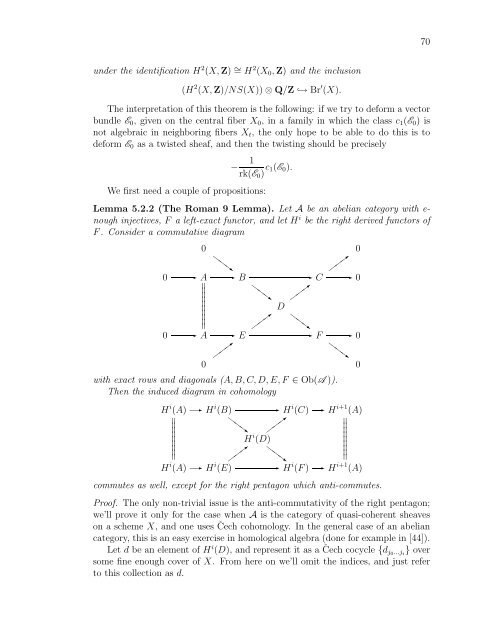derived categories of twisted sheaves on calabi-yau manifolds
derived categories of twisted sheaves on calabi-yau manifolds
derived categories of twisted sheaves on calabi-yau manifolds
You also want an ePaper? Increase the reach of your titles
YUMPU automatically turns print PDFs into web optimized ePapers that Google loves.
under the identificati<strong>on</strong> H 2 (X, Z) ∼ = H 2 (X0, Z) and the inclusi<strong>on</strong><br />
(H 2 (X, Z)/NS(X)) ⊗ Q/Z ↩→ Br ′ (X).<br />
The interpretati<strong>on</strong> <str<strong>on</strong>g>of</str<strong>on</strong>g> this theorem is the following: if we try to deform a vector<br />
bundle E0, given <strong>on</strong> the central fiber X0, in a family in which the class c1(E0) is<br />
not algebraic in neighboring fibers Xt, the <strong>on</strong>ly hope to be able to do this is to<br />
deform E0 as a <str<strong>on</strong>g>twisted</str<strong>on</strong>g> sheaf, and then the twisting should be precisely<br />
− 1<br />
rk(E0) c1(E0).<br />
We first need a couple <str<strong>on</strong>g>of</str<strong>on</strong>g> propositi<strong>on</strong>s:<br />
Lemma 5.2.2 (The Roman 9 Lemma). Let A be an abelian category with enough<br />
injectives, F a left-exact functor, and let H i be the right <str<strong>on</strong>g>derived</str<strong>on</strong>g> functors <str<strong>on</strong>g>of</str<strong>on</strong>g><br />
F . C<strong>on</strong>sider a commutative diagram<br />
0 0<br />
❩ ❩❩⑦ ✚ ✚ ✚❃<br />
0 ✲ A ✲ B<br />
❩<br />
❩❩⑦<br />
✲ C<br />
✚<br />
✚<br />
✲ 0<br />
✚❃<br />
✚<br />
D<br />
✚✚❃<br />
❩ 0<br />
<br />
<br />
<br />
<br />
<br />
<br />
<br />
<br />
<br />
<br />
✲ A ✲ E<br />
❩<br />
❩⑦<br />
✲ F ✲ 0<br />
✚ ✚✚❃<br />
❩ 0<br />
❩<br />
❩⑦<br />
0<br />
with exact rows and diag<strong>on</strong>als (A, B, C, D, E, F ∈ Ob(A )).<br />
Then the induced diagram in cohomology<br />
H i (A) ✲ H i (B) ✲ H i (C) ✲ H i+1 (A)<br />
❩<br />
❩❩⑦ ✚<br />
✚ ✚❃<br />
H i (D)<br />
✚ ✚✚❃<br />
❩ ❩<br />
❩⑦<br />
H i <br />
<br />
<br />
<br />
<br />
<br />
<br />
<br />
<br />
<br />
<br />
<br />
<br />
<br />
<br />
<br />
<br />
<br />
(A) ✲ i<br />
H (E) ✲ i<br />
H (F ) ✲ i+1<br />
H (A)<br />
commutes as well, except for the right pentag<strong>on</strong> which anti-commutes.<br />
Pro<str<strong>on</strong>g>of</str<strong>on</strong>g>. The <strong>on</strong>ly n<strong>on</strong>-trivial issue is the anti-commutativity <str<strong>on</strong>g>of</str<strong>on</strong>g> the right pentag<strong>on</strong>;<br />
we’ll prove it <strong>on</strong>ly for the case when A is the category <str<strong>on</strong>g>of</str<strong>on</strong>g> quasi-coherent <str<strong>on</strong>g>sheaves</str<strong>on</strong>g><br />
<strong>on</strong> a scheme X, and <strong>on</strong>e uses Čech cohomology. In the general case <str<strong>on</strong>g>of</str<strong>on</strong>g> an abelian<br />
category, this is an easy exercise in homological algebra (d<strong>on</strong>e for example in [44]).<br />
Let d be an element <str<strong>on</strong>g>of</str<strong>on</strong>g> Hi (D), and represent it as a Čech cocycle {dj0...ji } over<br />
some fine enough cover <str<strong>on</strong>g>of</str<strong>on</strong>g> X. From here <strong>on</strong> we’ll omit the indices, and just refer<br />
to this collecti<strong>on</strong> as d.<br />
70
















